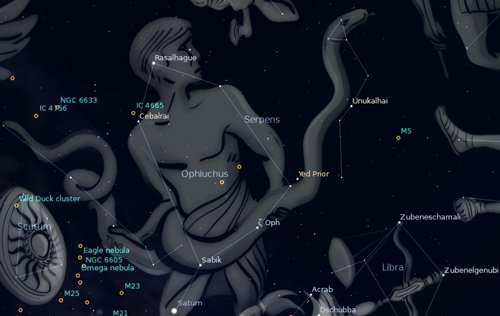This Week’s Sky at a Glance, July 15 – July 22 ~by Curt Nason
Serpens the Serpent is unique among the 88 constellations in that it is split in two by another constellation, Ophiuchus. As the name suggests, Ophiuchus is the Serpent Bearer, and he is often depicted holding a large snake behind his back. The two constellations are also intertwined in mythology.
Ophiuchus represents Asclepius, a renowned healer who could raise the dead. After killing a snake one day, he watched as another snake placed an herb on its dead companion and revived it. From this, Asclepius learned the healing arts and his success at reviving people drew the ire of Hades, a brother of Zeus and ruler of the underworld. Receiving a complaint from Hades that he was being robbed of subjects, Zeus killed Asclepius with a thunderbolt.
The part of Serpens west of Ophiuchus is called Serpens Caput (meaning head); to the east is Serpens Cauda (for tail). M16, the Eagle Nebula, is a rather faint nebula with a star cluster in Serpens Cauda. It gained fame as the iconic Pillars of Creation photo from the early years of the Hubble Space Telescope. The delightful globular cluster M5 is found in Serpens Caput.
This Week in the Solar System
Saturday’s sunrise in Moncton is at 5:43 am and sunset will occur at 9:06 pm, giving 15 hours, 23 minutes of daylight (5:51 am and 9:08 pm in Saint John). Next Saturday the Sun will rise at 5:50 am and set at 9:00 pm, giving 15 hours, 10 minutes of daylight (5:58 am and 9:02 pm in Saint John).
The Moon is at third quarter on Sunday, and it passes near Venus on Thursday morning. Mercury continues to pull away from the Sun in the evening sky but it still sets 70 minutes after sunset midweek. Jupiter is best observed in the first hour or so after sunset, before it gets too low in the west for steady viewing. Saturn is well placed for observing all evening between Scorpius and Sagittarius. Venus is the bright Morning Star, also called Phosphorus by the ancient Greeks and Lucifer by their Roman counterparts.
Astronomy clubs across the country are participating in a public National Star Party on the evening of July 29. New Brunswick locations are Mactaquac Provincial Park and the Irving Nature Park in Saint John.
Questions? Contact Curt Nason at nasonc@nbnet.nb.ca.

